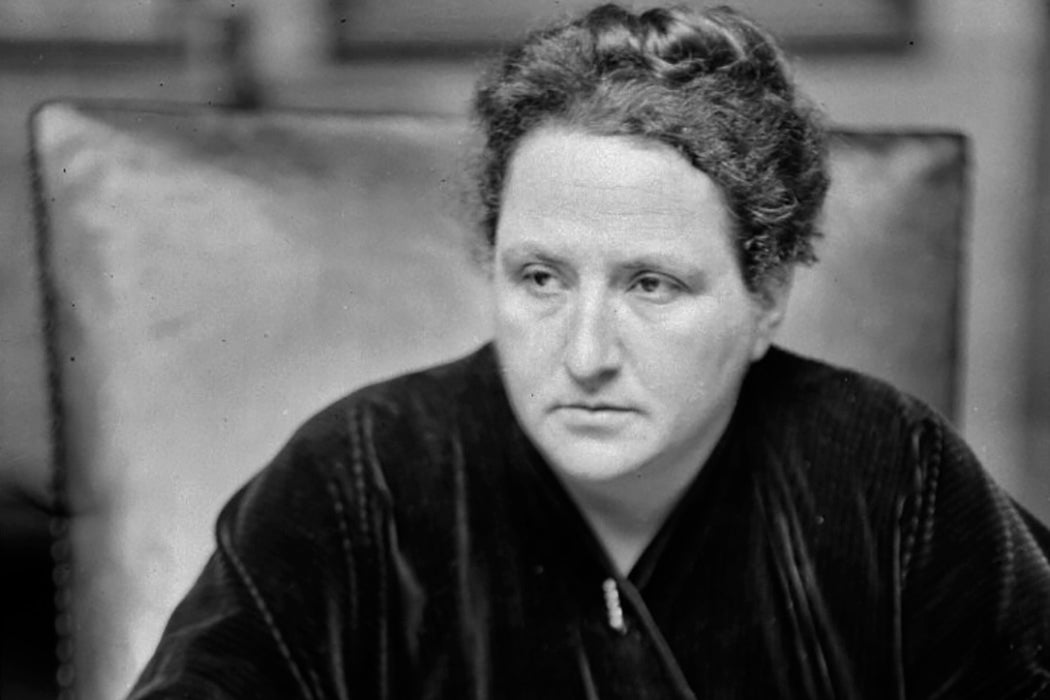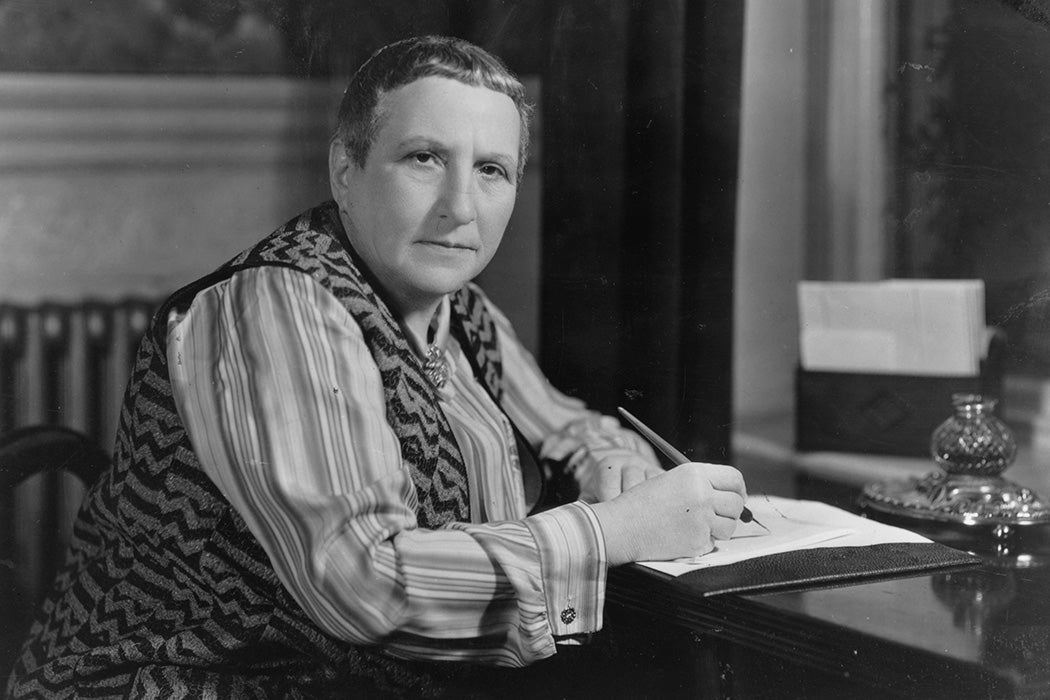It’s a mystery, really—a paradox or an enigma. Choose a door and it leads to another door. And another. Until, finally, you reach … a locked one. This is puzzling because the pattern is uniformly disrupted. Puzzles are puzzling at the first, when one doesn’t know where to start to begin where the puzzle takes root establishing the scene, piece by (bloody) piece.
The work of American writer—American expatriate, modernist writer extraordinaire—Gertrude Stein is at times puzzling, but always delightful because language becomes a playground, a landscape populated with metallic swings which sway sideways; monkey bars with labyrinthine constructions; everything necessarily, and properly, out of joint, like Hamlet’s time/sense. Stein warps reality to give us a taste—or perhaps an impression of—beginning and beginning again, but from different points within the Venn diagram of paragraphically rich distortions.
So the place to start is the enigma, the veiled curiosity of a modernist parallax. When the center of that wondrous subject is Stein, the puzzle collapses under the weight of deep scrutiny, and realigns itself accordingly, or rather fittingly, floating enticingly before the eyes. Indeed, the opening of the 1936 crime story, “Is Dead,” illustrates Stein’s wonderful use of syntax, irony, the cool aside, against the imagery of a murder mystery.
A hotel in the country is not the same as a hotel in a town but it is in a small town. They all went to the funeral. They passed up near the corpse, they kissed the cross, they were sprayed by the censer and they passed near where they the five of them, perhaps more were standing. It was not terrible.
They find likely that she was dead. She fell upon the pavement of cement in the court and broke her back but did not die nor did she know why. In five days she was dead.
Do you see what I mean.
Yes, we do.
But it has taken decades for an appreciation of Stein’s crime fiction to really take hold. Her work was indelibly literary in nature, her reach obvious from the beginning because she could name a thing with precision and wit. The famous epigraph, “You are all a lost generation,” from Ernest Hemingway’s The Sun Also Rises (1926), his debut novel, put a name to the feeling of those men —like Hemingway—who had returned from the Great War disillusioned and broken. Stein could sense the currents of new movements in art and literature. Indeed, she believed that detective fiction—in the American tradition of Dashiell Hammett, and perhaps some English approximations of the genre—could lay the groundwork for a new type of fiction. Stein was a modernist in that very modernist way of not being easy to read, or to understand, whose works fractured narrative expectation from word one.
A Modernist Movement in the Key of ‘G’
To understand Gertrude Stein’s place in American Literature—and modernist literature as a whole—is to take a journey through a fascinating history. The author of Three Lives (1909), Tender Buttons (1914), The Making of Americans (1925), The Autobiography of Alice B. Toklas (1933), and many others works, collected and uncollected, Stein frequently defied easy classification.
It all starts with Stein’s birth in Allegheny, Pennsylvania on Feb. 3, 1874. As an adult, she eventually trained in medicine, studying at Johns Hopkins University (she earned an undergraduate degree in psychology from Radcliffe College in 1898 under famed psychologist William James, the brother of Henry), but left without completing her degree. Puzzles fascinated her, and in a way, her journey from America to Paris (with her brother Leo) provided enough enigmas to explore, as she deepened “her theories of art and the literary experiments she was undertaking,” as Shari Benstock writes in Women of the Left Bank. Perhaps moving from medical mysteries to more provocative ones, such as the mystery of trying to convey what a Picasso painting does to the viewer in a particular set of words, helped to reinvent—and recontextualize—what art could do under modernist pressure.
Weekly Newsletter
“In the years when she worked at night in the rue de Fleurus [she moved to Paris in 1903], isolated from the larger literary community growing up around her,” Benstock explains, “she was learning something about her methods from the visual arts, by watching the practice of the Cubists, who divorced painting from representation and broke the visual subject into its component lines and dimensions. Stein knew that her experiments with language were similar to Picasso’s efforts in painting.” It borders on cliché to remark, without irony, that Stein was an original, but in her life and in her art, she embodied this like no other: geography—the Left Bank in particular—played an essential role in this development.
France, arguably, is the true starting place of Stein’s famous legacy. It might, at this juncture, seem highly reductive to invoke the Marvel Universe in providing an analogous example to show how Stein “brushed up” against many of the key figures of the modernist period, from the 1920s to the postwar 1940s. However, like Stan Lee’s Marvel Comics characters coming into contact with one another, where the Silver Surfer might meet Spider-Man, or Captain America might have a conversation with Charles Xavier of the X-Men; so too, did Stein influence, serve as patron, mentor, and interlocutor, to a veritable “who’s who” of modernist literature and art.

Her Paris address—known as “the salon” —on 27 rue de Fleurus was like a meeting in the pantheon of the literary gods. This list, while far from exhaustive, goes something like this: Pablo Picasso, Ernest Hemingway, Sherwood Anderson, F. Scott Fitzgerald, Mina Loy, and others (she even had a fruitful correspondence with the author of Native Son, Richard Wright). Stein’s influence hangs over it all, American and world literature like a strange attractor. When you factor into this enigmatic equation that Stein was a woman in a loving relationship with another woman (the titular Alice of The Autobiography of Alice B. Toklas, her most popular work during her lifetime), you see not merely a female writer of the 20th century, but an American writer of uncanny gifts, who could detect something essential in the pulp genre of the 1920s-1930s, particularly crime fiction—and, tangentially, some feeling for at least one science fiction writer (more on that later).
Ever the artistic wanderer, Stein intuited, through some literary-cultural echolocation, that something was happening in American literature. Yes, things were always happening in American literature, but unlike the experiments occurring in the writing of Left Bank expatriates such as herself, the detective story was coming into its own, as perhaps another reaction to modernity via the world of detection.
Stein delves into the pulp genre in her essay, “What Are Master-pieces and Why Are There So Few of Them,” while ruminating on literature and its aims. Or rather, she gives the reader a sampling of her theory in support of the crime story as literature; as a subset of something new awakening in American culture: whether it—the country, the populace—was aware of it, or not.
“It is very curious,” she writes, “but the detective story which is you might say the only really modern novel form that has come into existence gets rid of human nature by having the man dead to begin with the hero is dead to begin with and so you have so to speak got rid of the event before the book begins … In real life people are interested in the crime more than they are in detection … but in the story it is the detection that holds the interest.”
We might consider how this relates to writers such as Dashiell Hammett, author of The Maltese Falcon, who straddles the line between literature and pulp fiction. In “Making ‘Literature’ of It: Hammett and High Culture,” Mark McGurl makes the case for Hammett’s literary situation— as in where his work is situated in relation to “highbrow” literature and crime fiction. Hammett’s writerly efforts elevated pulp fiction to an art, in conversation with modernism. McGurl posits:
Admired by such [writers] as André Gide, André Malraux and Stein, Hammett’s fiction echoes the more obviously elite modernism whose central texts he appreciated and discussed even as he continued to sell his work to the pulp audience. His work shows us both what modernism looks like to mass culture and what mass culture looks like to modernism, without canceling the relative autonomy of these two discourses.
Hammett even says in a letter to Blanche Knopf: “Some day somebody’s going to make ‘literature’ of it,” referring to the detective story, and its nascent, yet-to-be-revealed potential. Indeed, Stein not only admired the genre from afar, she made her own attempts at the detective story. According to Brooks Landon, Stein wrote “a short play, ‘Three Sisters Who Are Not Sisters,’ a curious 80-page short novel, Blood On the Dining-Room Floor, an impenetrable thirty-page piece enigmatically titled ‘Subject Cases: The Background of a Detective Story,’ and several other short works with detective themes or subjects.”
These experiments were, as Landon intimated, structural in nature; Stein enjoyed playing with the form of the detective story, but moreover, she enjoyed reading the work of Hammett, a former private detective. Robert Polito in his introduction to Everyman’s Library’s collection of The Maltese Falcon, The Thin Man, Red Harvest, discusses how Stein met Hammett in Los Angeles while she was on her American lecture tour in 1935 and how they engaged in an intriguing conversation about nineteenth and twentieth century literature, surrounding the idea of gender identity and a man’s “confidence.”

After the success of 1933’s The Autobiography of Alice B. Toklas, Stein struggled with … words of all things. “In the summer of 1933 and just prior to her six-month celebrity tour of the United States,” writes Amy Moorman Robbins, “Gertrude Stein is said to have suffered the only case of writer’s block she ever knew, a problem that she seems to have solved through the act of composing her curious little detective novel, Blood on the Dining-Room Floor.” Although Blood on the Dining-Room Floor was unpublished during Stein’s lifetime, it has seen publication in variety of presses, most notably, Dover, and continues to spark conversation. The idea for the book was inspired by Stein’s own experience with the strange death of Madame Pernollet, an owner of a hotel in Belley, France who reportedly fell to her death from one of the hotel’s windows. Stein and Toklas knew Pernollet, and this strange tragedy set Stein’s nimble mind alight with questions and the undertaking of her own murder mystery in the guise of Blood on the Dining-Room Floor.
Early in the novel, Stein writes, “How did she die. Now I will try to tell. How she fell. And she was dead. Not at once. But in five days. Although many wanted to send flowers, in case, that she was, already dead. How can she die if it is not right to die. In some countries nobody can die if it is not right to be dead.”
Maybe the idea was not quite Hammett, but it orbited around the general notion put forth by crime fiction—the missing pieces around an unexplained death. Polito adds: “Stein esteemed Hammett as a crucial American novelist. She invoked his writing as a counterpart to her own experiments in the assiduous stripping away of nineteenth-century psychology, character, even plot from twentieth-century fiction.” It is no surprise that the detective stories of Hammett in Black Mask (a pulp magazine published from 1920-1951) provided some needed inspiration. Fame, as it turns out, blunted her creativity for a brief time.
During this period, Stein delved into her “pulp explorations,” slipping across the unknown, as a kind of story engine to prime the writing. Whether these works are successful artistically is really beside the point—that they exist is a beautiful testament to Stein’s creative mind, and to the connective tissue evident in modernist literature and the pulp fiction emerging during that time. There is something liberating about genre—what it can attempt; what it can embody as “safe spaces” for writers and artists to express new, untried ideas and techniques.
Stein drank deeply from this well and was even sympathetic to books with “ray guns” and “scientifiction” leanings. Take for instance, the now mostly forgotten science fiction novel The Eater of Darkness (1926) by Robert M. Coates. Published in Paris, and an example of “modernism and pulp sf [colliding],” Paul March-Russell explains in Modernism and Science Fiction, “Gertrude Stein brought the novel to the attention of Robert McAlmon, publisher of Contact Editions. McAlmon, who had typed-out the manuscript of Joyce’s Ulysses, launched his imprint in 1922 with money from his wife, Annie Winifred Ellerman (better known as Bryher), the lover and patron of H.D. [Hilda Doolittle] Besides Barnes, H.D. and Stein, McAlmon also published pioneering work by Hemingway, Mary Butts, Mina Loy, and William Carlos Williams.”
Scholars such as Paul March-Russell, Amy Moorman Robbins, Matthew Levay, Brooks Landon, Jason Ray Carney, and others have written about this connection extensively, and more scholars are finding the connection between modernism and genre fiction worthy of another glance. That Stein “played for a moment” round the interstices of pulp fiction and modernist literature, is reason enough for celebration.
‘Read her with her …’
The ground on which modernism stands is, like August Wilson’s decree, in need of resettling, rethinking, and restructuring. Stein might have died in 1946, but Blood On the Dining-Room Floor, “Is Dead,” “Three Sisters Who Are Not Sisters,” and “Subject Cases: The Background of a Detective Story,” are all part of Stein’s impressive, caustically-alive corpus. The stuff that points to pop—to popular culture, to pulp, to crime fiction, seems to topple that modernist monolith with a cosmic shove. In a world where—to the horror of Theodor Adorno and Max Horkheimer’s “Culture Industry” —the walls are breaking down between what we have all come to know as “high” and “low” culture, literary, and escapist, one person’s trash is always another’s artistic reckoning. Stein was already dipping her finger into that cultural soup. She found it in need of seasoning, desiring a new recipe.
In Tender Buttons, Stein writes under “A TIME TO EAT”: “A pleasant simple habitual and tyrannical and authorized and educated and resumed and articulate separation. This is not tardy.”) Then, under the food section of the same work, under “A CENTRE IN A TABLE,” she ruminates, “Next to me next to a folder, next to a folder some waiter, next to a foldersome waiter and re letter and read her. Read her with her for less.”
Indeed, read her—with her. For the adventure. The detection. The Steinese. For the word soup et al.
You Might Like
How We Escape It: An Essay
Support JSTOR Daily! Join our new membership program on Patreon today.








